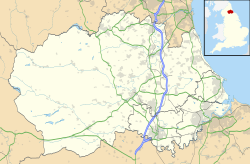Hartlepool Abbey facts for kids
| Monastery information | |
|---|---|
| Established | 640CE |
| Disestablished | c.800CE |
| People | |
| Founder(s) | Hieu, Aidan of Lindisfarne |
| Important associated figures | Ælfflæd of Whitby, Hilda of Whitby |
| Site | |
| Coordinates | 54°41′42.43″N 1°10′53.59″W / 54.6951194°N 1.1815528°W |
Hartlepool Abbey, also known by names like Heretu Abbey, was an important monastery in Northumbria, an old kingdom in England. It was started in 640 CE. Two key people founded it: Hieu, who was a very respected religious woman, and Aidan of Lindisfarne, a famous bishop. The abbey was built on the Headland Estate in Hartlepool, which is now in County Durham, England.
Contents
Building the Abbey
What it Looked Like
The abbey was built in an early Saxon style. It was probably a walled area with simple wooden huts. These huts would have surrounded a main church building.
A Special Kind of Monastery
Hartlepool Abbey was a special type of place called a double monastery. This meant it was home to both monks (men) and nuns (women). From 640 to 649, Hieu was in charge. She was the first female abbess to lead such a place. Hilda, another important leader, also guided both men and women. Old writings by a monk named Bede mention male students at Hilda's monasteries. We also know that male names were found on gravestones in the abbey's cemetery.
Most of the priests at the abbey came from the Celtic church. They had traveled to Northumbria from places like Ireland or the island of Iona. Other priests arrived as part of the Pope's mission to Britain.
History of Hartlepool Abbey
Early Leaders
In 640, Bishop Aidan chose Hieu to start and lead the new abbey at Hereteu. Hieu stayed there until 649. After she left for Tadcaster, Hilda became the second abbess. Bishop Aidan also appointed her.
When Hilda arrived, there were some problems with the monks. Hilda was a great organizer. She made sure everyone followed a clear plan for prayer, work, and rest.
King Oswiu's Daughter
In 655, King Oswiu of Northumbria sent his one-year-old daughter, Ælfflæd, to live with Hilda. This was a very important act. It meant Ælfflæd would be dedicated to God and live a religious life forever. Hilda stayed at Hartlepool Abbey until 657 or 658.
Moving On
At Bishop Aidan's request, Hilda then became the first abbess of Whitby Abbey. This new abbey was called Streoneshalh back then. Hilda took Ælfflæd and ten nuns with her. Even though she lived at Streaneshalch, Hilda was still technically in charge of both monasteries.
After this, Hartlepool Abbey seems to disappear from history. It's possible it stopped working. Or maybe it moved and became the start of Hilda's new abbey at Whitby.
What Happened Next
The Village and the Vikings
A village grew up around the monastery in the 7th century. This was the very beginning of the modern town of Hartlepool. However, after Hilda left, the abbey and its village are not mentioned again until the 12th century. It seems the abbey became less important.
It might have been attacked and destroyed by Danish Vikings around 800. Or it might have simply been left empty.

Leaders of the Abbey
Here is a list of the women who led Hartlepool Abbey:
| Name | Date appointed Abbess | Date Left | Notes | went to |
|---|---|---|---|---|
| Hieu | 640AD | 649AD | Founder of Abbey | Tadcaster |
| Hilda | 649AD | 658AD | Whitby Abbey |
Finding Clues: Excavations
Discoveries in 1883
Today, there are no visible signs of the old monastery. But its cemetery has been found near where St Hilda’s Church stands now. This cemetery is the most explored of all the old Northumbrian monasteries from the 7th and 8th centuries.
The first dig happened in 1833. Workers building houses found human burials and Anglo-Saxon items. They found several female skeletons lying in two rows. Their heads rested on flat stones like pillows. Larger stones with Anglo-Saxon runes (an old alphabet) and crosses were placed above them. One of these special name-stones is now on display in St Hilda's Church. Experts from the British Archaeological Association helped identify some of the names. These included Heresuid and Bregesuid (Hilda's sister and mother), Frigyd (an abbess from Hackness), and Hildilid, Eadgyd, and Torchtgyd (leaders and nuns from Barking Abbey).
Time Team in 2000
Even today, new discoveries are still being made! Hartlepool Abbey was featured on the TV show Time Team in March 2000. The episode was called "Nuns in Northumbria." During this dig, bones and a book clasp were found, giving us more clues about this ancient place.


